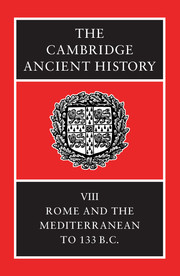Book contents
- Frontmatter
- Contents
- List of maps
- List of text-figures
- Preface
- 1 Sources
- 2 The Carthaginians in Spain
- 3 The Second Punic War
- 4 Rome and Greece to 205 B.C.
- 5 Roman expansion in the west
- 6 Roman government and politics, 200-134 B.C.
- 7 Rome and Italy in the second century B.C.
- 8 Rome against Philip and Antiochus
- 9 Rome, the fall of Macedon and the sack of Corinth
- 10 The Seleucids and their rivals
- 11 The Greeks of Bactria and India
- 12 Roman tradition and the Greek world
- 13 The transformation of Italy, 300 – 133 B.C. The evidence of archaeology
- Three Hellenistic Dynasties
- Genealogical Tables
- Chronological Table
- BIBLIOGRAPHY
- Index
- Map 11: Greece and Asia Minor
- Map 13: Asia Minor and Syria
- References
12 - Roman tradition and the Greek world
Published online by Cambridge University Press: 28 March 2008
- Frontmatter
- Contents
- List of maps
- List of text-figures
- Preface
- 1 Sources
- 2 The Carthaginians in Spain
- 3 The Second Punic War
- 4 Rome and Greece to 205 B.C.
- 5 Roman expansion in the west
- 6 Roman government and politics, 200-134 B.C.
- 7 Rome and Italy in the second century B.C.
- 8 Rome against Philip and Antiochus
- 9 Rome, the fall of Macedon and the sack of Corinth
- 10 The Seleucids and their rivals
- 11 The Greeks of Bactria and India
- 12 Roman tradition and the Greek world
- 13 The transformation of Italy, 300 – 133 B.C. The evidence of archaeology
- Three Hellenistic Dynasties
- Genealogical Tables
- Chronological Table
- BIBLIOGRAPHY
- Index
- Map 11: Greece and Asia Minor
- Map 13: Asia Minor and Syria
- References
Summary
THE ROMAN TRADITION
It is difficult to look directly at the Rome of the late third century and isolate her characteristics and traditions; too little contemporary evidence survives. Perhaps we may do best to attempt to see her first through the eyes of two contrasted writers, Polybius and Fabius Pictor. Polybius wrote in the middle of the second century, but tried to describe the Romans in his first book as they were at the time of the First Punic War, while his extended account in book VI of their institutions is meant to be a picture of these as they were at their best, near the start of the struggle against Hannibal.
That ‘best’ should give us pause, and of course Polybius’ sources were primarily aristocratic Romans looking back to an idealized past. But Polybius is not entirely uncritical. His Romans are also more unlike his own familiar Greeks than is sometimes supposed. Above all, they are soldiers: immensely courageous, partly because subject to a strict and indeed terrifying discipline, though also spurred on by praise and rewards; persistent to the point of obstinacy – they think that force can control even the weather, and thus, impressive as their rapid and determined building of a fleet against the Carthaginians was, they have frequently met disaster at sea. Their haughtiness, especially in defeat, is imposing, but sometimes impractical. At a later point Polybius notes their thoroughness when sacking a town – they even dismember the dogs. In book VI he shows a great admiration not only for the structure and weapons of the legion, so different from those of the Greek phalanx, but for the whole way in which a campaign is organized, following it from the first enlistment of the men to the measuring of the camp.
- Type
- Chapter
- Information
- The Cambridge Ancient History , pp. 422 - 476Publisher: Cambridge University PressPrint publication year: 1989
References
- 5
- Cited by

